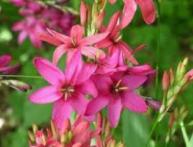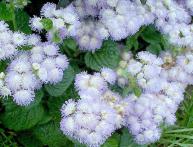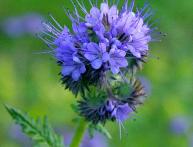Pachypodium lamera: features of care and planting at home
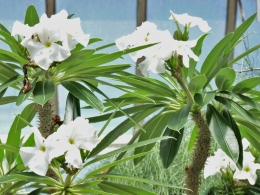
Pachypodium lamera is a plant that will appeal to almost every flower lover. It will appeal to both cactus lovers, since it has sharp spines on the stem, and lovers of plants with lush foliage. In appearance, the flower resembles a small palm tree, but it is in no way related to it, and comes from a completely different genus. How to care for a plant at home, and other nuances will be discussed in the article.
Content:
A little about the plant
In the wild, pachypodium reaches a height of 8 meters, and even higher. But the maximum growth of a plant at home does not exceed 1.5 meters. If you decide to have such a flower at home, then you need to be patient, because pachypodium grows very slowly, no more than 5 cm per year, but with proper care, after 5-7 years it will give you beautiful flowers.
The stem of the flower is quite thick, covered with large and spreading leaves, under each of which there are three large and sharp thorns. This is how the plant protected itself in the wild. At the top there is a bunch of oblong leaves, thanks to which many note the similarity of the pachypodium to a small palm tree.
Features of growing Pachypodium lamera
Pachypodium lamera has a number of preferences and features care like any other plant. Let's take a closer look at them.
Soil selection. The flower does not make any special demands on the soil. A high-quality soil mixture purchased from a specialized store, as well as ordinary soil that you brought from the dacha and added a little river sand, are suitable for it. But by adding a little crushed red brick and charcoal, you will not only provide good drainage and access to oxygen, but also saturate the soil with the minerals necessary for growth.
In addition, charcoal has excellent disinfectant properties; it perfectly resists the development of infection or rotting of the rhizome. But, you need to use only charcoal from deciduous trees. To do this, just take a small dry birch branch and burn it.
Carefully break the firebrand that remains into pieces and gradually add it to the plant’s soil. The temperature regime also has very favorable characteristics.
In winter, the flower will tolerate an air temperature of up to 8 degrees above zero. In fact, there are very few flowers that can thrive at this temperature. Typically the minimum requirement for other colors is 16 degrees. But at this time it is better to limit watering to prevent rotting. root system.
In summer, it is best to keep the temperature at 25-27 degrees. Watering. This is where flower lovers have the most controversy. Some people believe that pachypodium lamera needs to be watered regularly, irrigating the soil a little so that it always contains moisture.
Others believe that it is necessary to water the soil in a pot only when it dries out. In any case, the optimal solution is to moisten the plant when the soil dries 1-2 cm.This way you can avoid overflowing, and the flower will not suffer from a lack of liquid.

In cold weather, watering should be kept to a minimum, since moisture does not evaporate as quickly, and the flower does not absorb as many nutrients, being in a period of slow development. You also don’t have to worry about lighting. Pachypodium tolerates both direct sunlight and partial shade, and develops well in both situations.
The air humidity around the flower does not play any role. It feels great both in high humidity and near a battery. Additionally, there is no need to spray the plant with a spray bottle, except for hygiene purposes. Transfer. The plant does not need constant replanting: a young plant needs to change the pot to a larger one once a year, but an adult pachypodium is better left alone for 2-3 years.
During replanting, be sure to ensure good drainage; fill at least a third of the pot with it, so as not to get stagnant water. Fertilizers. You need to feed the flower every two weeks in autumn and spring, using mineral fertilizers with a low nitrogen content. After transplanting the plant, you do not need to touch it for about a month while it adapts and gets used to the new living conditions.
By adhering to these simple rules, you will get a healthy and beautiful flower that looks very original in an ordinary apartment or house.
Important facts about the flower
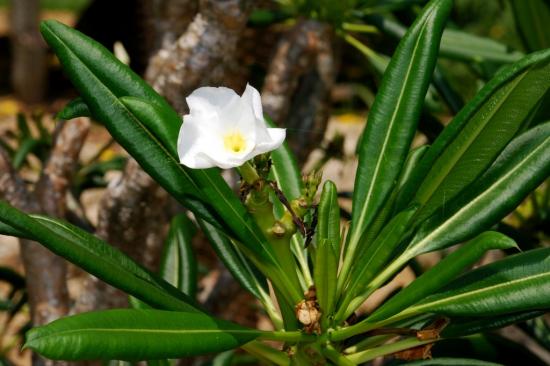
There are several features of Pachypodium lamera that you need to know before planting:
- The plant can shed leaves in the autumn-winter period. This is considered absolutely normal, pachypodium behaves like most plants at this time.A flower can be considered healthy if there is still a small “forelock” left on top.
- To rectify the situation water plant 5-6 weeks. And, as soon as you notice new leaves, feel free to reward your home “palm” with moisture.
- The flower is very attached to its corner and does not tolerate rearrangements. Pachypodium lamera may get sick or lose all its leaves just because you turned the pot with the other side towards the window.
Pachypodium does not tolerate drafts; they can destroy it. It will tell you that the plant is overcooling: the leaves will begin to turn black and fall off, and the trunk will become limp and lose its elasticity. If nothing is done in this situation, the plant will simply rot. In summer, if possible, move the plant into fresh air. There the growth will improve and the pachypodium will become fresher.
In addition, the flow of oxygen has a beneficial effect on the general condition of the flower. It is worth mentioning another very important feature of the flower - it has very poisonous juice. Therefore, despite its beauty and ease of care, pachypodium lamera is simply prohibited from being kept in a house where there are small children or animals. And for safety reasons, it is better not to keep such a danger in a residential area at all. You need to work with the flower only with gloves.
Even if you get pricked by a thorn while leaving, and then come across a slightly broken leaf, you can get seriously poisoned. As you can see, the flower does not need constant care, or special procedures, so maintaining it is quite simple. But whether the beauty is worth the risk of poisoning from the plant juice is up to you to decide.
Video about the flower Pachypodium lamera:




